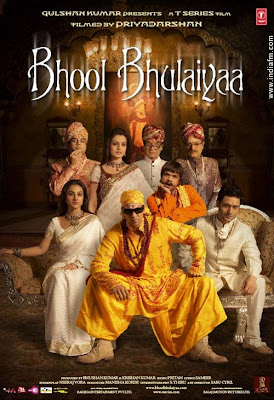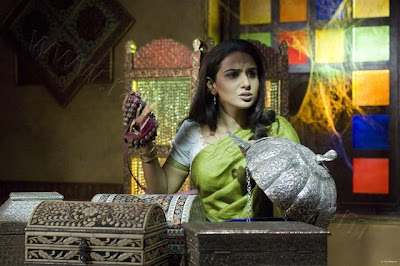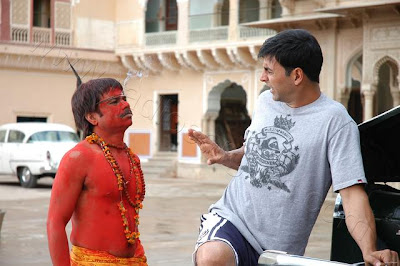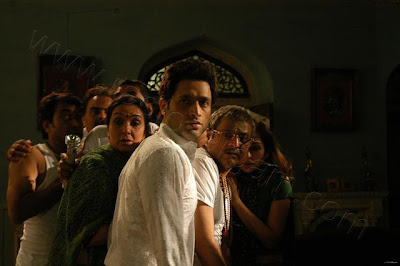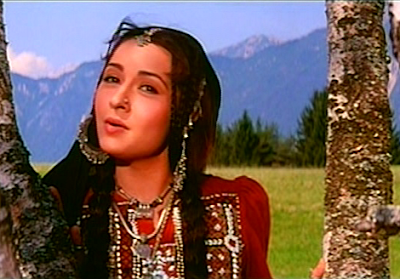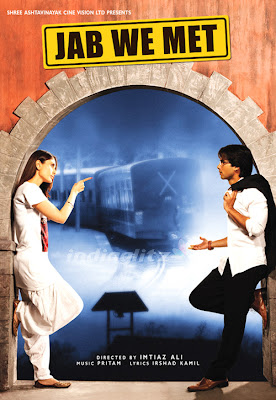
Take a sassy Sikhni from Batinda, a bashful business man; add a splash of Punjabi merriment and the result is Jab We Met…the burlesque romantic drama of the season.
As the lights go down in the cinema hall and the first scenes of a brooding and despondent Shahid Kapur appear on the screen, one is somewhat taken aback by Imtiaz Ali’s choice opening in what is supposed to be a frolicking romp of love and relationships.
However, our minds then flashback to 2005 when he presented us with the finely crafted Socha Na Tha, a film that showcased his potential as a director and presented an otherwise hackneyed love story in a rejuvenating manner, reaffirming our confidence that Jab We Met will certainly be a notch higher.
So the show begins with Aditya (Shahid Kapur), as he walks about his surroundings in a nonchalant demeanor, the sorrows of his life clearly visible on his face…and although we are offered no explanation as to why, we are grateful that we spared the often predictable and mundane monologues that Hindi cinema is so typical for when attempting to explain the banes of a characters life.
Instead, through slick camera shots and angles, we learn that Aditya has actually been jilted by his lover…and as result of this depressing awakening, is now aimless and beaten by the gripe of life. The beauty of Imtiaz’s Ali’s film has just begun to unfold…an avant-garde style of presenting the facts but without dawning upon them, letting the camera capture visuals that speak a hundred more words than any dialogues can.
Ebbing away is the will to live and Aditya remains enclosed in a bubble of confusion and dejection…a bubble which pops as loudly as a champagne bottle, fizzing away furiously as it drips and drabbles, and in its gushiest moment brings Geet (Kareena Kapoor) to the forefront…Geet who explodes onto the screen with the exact vigorousness of Moet and leaves a taste just as enticing.
Geet is everything that a never ending record can be…extremely satisfying to the earlobes but equally painful to the head yet she brings the required zest into Aditya’s life just when he felt that thunderclouds were only effusing upon him.
After a tumultuous encounter on a train ride to Bhatinda which ultimately ends in havoc, Aditya and Geet are left stranded in each other’s company…both occupy the jewels of life that the other needs. Whilst Aditya’s practical outlook and shrouded in realism approach brings the necessary restraint into Geet’s bumbling existence, Geet hands Aditya the jewel of hope and living for the moment…thus starting the beginning of an endearing relationship.
However, Geet has a problem. A problem which lies within the vibrant and chirpy home of her Punjabi household where her family members are preparing to marry her off to childhood sweetheart Manjeet. Yet, Manjeet has been replaced by long time lover Ashuman in Geet’s marital dreams of shenai and shaguns, a reality she is sure her family will disapprove of.
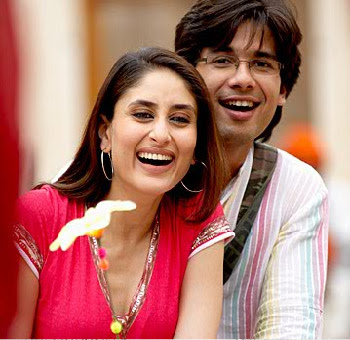
Unaware of the ensuing dilemma, Aditya escorts Geet back to her family home safely and as a result, becomes a guest amongst the bustling preparations whilst Geet awaits the right moment for her to flee into the arms of her beau.
God made time, man made haste…and haste is exactly what entangles Geet into an awakening of reality, leaving her at a point where she can no longer turn back and head down the path that once led to the ultimate quirky Sikhni of Batinda that she once was.
Could Aditya be that resolve? Unknowingly, Geet has traded part of herself into Aditya’s own being and now it is only he who can and will restore the tinted rose glasses that Geet viewed the world with. As a savior, he enters Geet’s world yet again, igniting his true feelings for her but this time with one motive, to put the sassy back into the Sikhni…
So what works about Jab We Met? The answer is quite simply everything! Imtiaz Ali has made a film which will appeal to almost every sector of the audience, complete wholesome entertainment, regulatory song and dance, romance, comedy…but all packaged in a chic and embryonic manner sans cliché and melodrama, which makes Jab We Met refreshing in its approach and piquant in its resolve.
The initial portions between Shahid Kapur and Kareena Kapoor set the tone immediately, with the interactions clearly defining the characters and Imtiaz Ali wastes no time with nonsensical characters but rather contends with the two protagonists of his story, which are in actual fact the meat of the film.
The sleek and direct shots in quick succession of Geet’s constant babbling are proof of the director’s ability to pack in punch without drawing out the obvious, which throws out the threat of insulting the viewer’s intelligence.
Likewise, the sequence of events from the train journey, to the couple spending a night in a bed-sit right through to the arrival in Bhatinda cuts out any frills and fancies but instead concentrates on establishing what makes the characters tick and lays a strong foundation for the second half.
Whilst the first half of the film is layered with comedy and chaos, the second half relies more on emotions and the transition of both the lead characters. Although there was the hazard of deviating from the plot with singular tracks around the family members, Imtiaz stays faithful to his vision and provides a satisfying insight into the minds of the protagonists resulting in a tidy climax.
Plaudits to Imtiaz Ali for his projection of a Punjabi family which is void of any stereotypes, a welcomed change after a long time. For years, we have been subjected to the clownish, garishly dressed and buffoonery antics of Punjabi characters on screen, many of which are found in abundance in Yash Chopra/Karan Johar cinematic ventures. Growing up in a Punjabi household means as a viewer I was able to identify with the characters on every level, be it the extremely realistic representation of Geet’s grandfather played to perfection by Dara Singh or the general acquirement of the hustle bustle that rules during weddings and functions.
Sahid Kapur deserves great credit for his work in Jab We Met speaking volumes with his eyes. It was very easy for him to be overshadowed by the extremely flamboyant character of Geet but instead he proves his mettle, churning out a sincere and flawless performance. The opening scene of the film shows how he excels in conveying so much through his mask of expression and likewise, in moments of comedy, he brings about the uneasiness of Aditya like a natural. In Vivaah, Shahid played a character which can be seen to be extremely removed from reality but in Jab We Met, his character is both identifiable and likeable. A man who is still paining from the desertion of his mother and lover…and how he reaches a position where he is both at ease with himself and the people around him is conveyed with extreme panache, credit to Imtiaz Ali’s direction and Shahid Kapur’s talent.
identifiable and likeable. A man who is still paining from the desertion of his mother and lover…and how he reaches a position where he is both at ease with himself and the people around him is conveyed with extreme panache, credit to Imtiaz Ali’s direction and Shahid Kapur’s talent.
Kareena Kapoor is a complete revelation. Although I have been skeptical in the past regarding her performances, in Jab We Met she transforms into Geet like a caterpillar to a butterfly, spreading her wings so far that her performance shows a varied range. Accused in the past of going overboard with her acting, it is exactly this trait that works for her in the film, the contorting facial expressions, highly charged delivery of dialogue and overt body language; everything works in favor for the character of Geet. Kareena is suited extremely well as the Punjabi girl both in looks and persona and one can see the painstaking attempt to make her appear authentic on screen. For example, her costumes, which are both tasteful and reflective of her Punjabi background, are taken one step further when we learn that in actual fact, Geet, the Sikhni from Bhatinda sleeps in a T-shirt and salwar…these minute details make us see only Geet rather than Kareena Kapoor and it is hard to imagine anyone else in her place. Even when the character is played down, Kareena manages to hit the right notes and still, glimmers of the zany Geet ebb through. A performance which reminded me greatly of the bubbly characters Juhi Chawla played in films like Andaz, Bol Radha Bol and One Two Ka Four with great ease; this is certainly one of Kareena Kapoor’s better examples of her talent.
Music is a huge asset to Jab We Met and Pritam has provided a refreshing and dynamic soundtrack. “Nagada Nagada” is likeable for its energetic and playful picturisation both generous in color and commotion. The use of Punjabi folklore throughout the song is outstanding and captures the spirit of the film instantly. If melody is the call of the day, then “Aao Milkar Chale” manages to serve the mushy palette and “Mauja Mauja” is scintillatingly seductive visually but perhaps deserved better placement in the story.

Technically the film loses a few points, purely for the fact that at times the wide-angled shots of the cars and trains appear as though they are in actual fact toys which gives the impression of an amateur. However, one is prepared to overlook this due to the engaging events on screen which make up for any minor glitches.
After a long time in Hindi cinema there has been a love story which throws out the mush and the predictability and instead presents a tangible tale of two yet still remains faithful to the idea of escapism.
Imtiaz Ali has to be commended for his no nonsense approach to directing and thanked for the fact that he trusts the audience to interpret the goings on as they feel apt without indulging in spoon feeding the viewers.
Just take for example, the symbolism of the train in the story…the very train on which Aditya and Geet meet and the very train which becomes the starting point of all their problems. The train which goes back and forth, back and forth carrying people to their destinations, it’s wheels furiously spinning in all its glory…yet it never becomes fully acquainted with its passengers as it’s too busy reaching its station and finally when it does halt to a stop, it finds itself desolate.
Similarly, just like the train in Jab We Met, Imtiaz Ali presents us with two characters that keep running on the same track, their passions and aspirations prove to be their steam and finally when they do stop…the journey proves to be life changing. This is the beauty of Jab We Met and exactly what makes it frivolous fun from the outside but a lot deeper on the inside.
A revivifying presentation laced with infectious comedy complete with soul, makes Jab We Met a meeting that certainly garners top place in your diary.
As the lights go down in the cinema hall and the first scenes of a brooding and despondent Shahid Kapur appear on the screen, one is somewhat taken aback by Imtiaz Ali’s choice opening in what is supposed to be a frolicking romp of love and relationships.
However, our minds then flashback to 2005 when he presented us with the finely crafted Socha Na Tha, a film that showcased his potential as a director and presented an otherwise hackneyed love story in a rejuvenating manner, reaffirming our confidence that Jab We Met will certainly be a notch higher.
So the show begins with Aditya (Shahid Kapur), as he walks about his surroundings in a nonchalant demeanor, the sorrows of his life clearly visible on his face…and although we are offered no explanation as to why, we are grateful that we spared the often predictable and mundane monologues that Hindi cinema is so typical for when attempting to explain the banes of a characters life.
Instead, through slick camera shots and angles, we learn that Aditya has actually been jilted by his lover…and as result of this depressing awakening, is now aimless and beaten by the gripe of life. The beauty of Imtiaz’s Ali’s film has just begun to unfold…an avant-garde style of presenting the facts but without dawning upon them, letting the camera capture visuals that speak a hundred more words than any dialogues can.
Ebbing away is the will to live and Aditya remains enclosed in a bubble of confusion and dejection…a bubble which pops as loudly as a champagne bottle, fizzing away furiously as it drips and drabbles, and in its gushiest moment brings Geet (Kareena Kapoor) to the forefront…Geet who explodes onto the screen with the exact vigorousness of Moet and leaves a taste just as enticing.

Geet is everything that a never ending record can be…extremely satisfying to the earlobes but equally painful to the head yet she brings the required zest into Aditya’s life just when he felt that thunderclouds were only effusing upon him.
After a tumultuous encounter on a train ride to Bhatinda which ultimately ends in havoc, Aditya and Geet are left stranded in each other’s company…both occupy the jewels of life that the other needs. Whilst Aditya’s practical outlook and shrouded in realism approach brings the necessary restraint into Geet’s bumbling existence, Geet hands Aditya the jewel of hope and living for the moment…thus starting the beginning of an endearing relationship.
However, Geet has a problem. A problem which lies within the vibrant and chirpy home of her Punjabi household where her family members are preparing to marry her off to childhood sweetheart Manjeet. Yet, Manjeet has been replaced by long time lover Ashuman in Geet’s marital dreams of shenai and shaguns, a reality she is sure her family will disapprove of.

Unaware of the ensuing dilemma, Aditya escorts Geet back to her family home safely and as a result, becomes a guest amongst the bustling preparations whilst Geet awaits the right moment for her to flee into the arms of her beau.
God made time, man made haste…and haste is exactly what entangles Geet into an awakening of reality, leaving her at a point where she can no longer turn back and head down the path that once led to the ultimate quirky Sikhni of Batinda that she once was.
Could Aditya be that resolve? Unknowingly, Geet has traded part of herself into Aditya’s own being and now it is only he who can and will restore the tinted rose glasses that Geet viewed the world with. As a savior, he enters Geet’s world yet again, igniting his true feelings for her but this time with one motive, to put the sassy back into the Sikhni…
So what works about Jab We Met? The answer is quite simply everything! Imtiaz Ali has made a film which will appeal to almost every sector of the audience, complete wholesome entertainment, regulatory song and dance, romance, comedy…but all packaged in a chic and embryonic manner sans cliché and melodrama, which makes Jab We Met refreshing in its approach and piquant in its resolve.
The initial portions between Shahid Kapur and Kareena Kapoor set the tone immediately, with the interactions clearly defining the characters and Imtiaz Ali wastes no time with nonsensical characters but rather contends with the two protagonists of his story, which are in actual fact the meat of the film.
The sleek and direct shots in quick succession of Geet’s constant babbling are proof of the director’s ability to pack in punch without drawing out the obvious, which throws out the threat of insulting the viewer’s intelligence.
Likewise, the sequence of events from the train journey, to the couple spending a night in a bed-sit right through to the arrival in Bhatinda cuts out any frills and fancies but instead concentrates on establishing what makes the characters tick and lays a strong foundation for the second half.
Whilst the first half of the film is layered with comedy and chaos, the second half relies more on emotions and the transition of both the lead characters. Although there was the hazard of deviating from the plot with singular tracks around the family members, Imtiaz stays faithful to his vision and provides a satisfying insight into the minds of the protagonists resulting in a tidy climax.

Plaudits to Imtiaz Ali for his projection of a Punjabi family which is void of any stereotypes, a welcomed change after a long time. For years, we have been subjected to the clownish, garishly dressed and buffoonery antics of Punjabi characters on screen, many of which are found in abundance in Yash Chopra/Karan Johar cinematic ventures. Growing up in a Punjabi household means as a viewer I was able to identify with the characters on every level, be it the extremely realistic representation of Geet’s grandfather played to perfection by Dara Singh or the general acquirement of the hustle bustle that rules during weddings and functions.
Sahid Kapur deserves great credit for his work in Jab We Met speaking volumes with his eyes. It was very easy for him to be overshadowed by the extremely flamboyant character of Geet but instead he proves his mettle, churning out a sincere and flawless performance. The opening scene of the film shows how he excels in conveying so much through his mask of expression and likewise, in moments of comedy, he brings about the uneasiness of Aditya like a natural. In Vivaah, Shahid played a character which can be seen to be extremely removed from reality but in Jab We Met, his character is both
 identifiable and likeable. A man who is still paining from the desertion of his mother and lover…and how he reaches a position where he is both at ease with himself and the people around him is conveyed with extreme panache, credit to Imtiaz Ali’s direction and Shahid Kapur’s talent.
identifiable and likeable. A man who is still paining from the desertion of his mother and lover…and how he reaches a position where he is both at ease with himself and the people around him is conveyed with extreme panache, credit to Imtiaz Ali’s direction and Shahid Kapur’s talent.Kareena Kapoor is a complete revelation. Although I have been skeptical in the past regarding her performances, in Jab We Met she transforms into Geet like a caterpillar to a butterfly, spreading her wings so far that her performance shows a varied range. Accused in the past of going overboard with her acting, it is exactly this trait that works for her in the film, the contorting facial expressions, highly charged delivery of dialogue and overt body language; everything works in favor for the character of Geet. Kareena is suited extremely well as the Punjabi girl both in looks and persona and one can see the painstaking attempt to make her appear authentic on screen. For example, her costumes, which are both tasteful and reflective of her Punjabi background, are taken one step further when we learn that in actual fact, Geet, the Sikhni from Bhatinda sleeps in a T-shirt and salwar…these minute details make us see only Geet rather than Kareena Kapoor and it is hard to imagine anyone else in her place. Even when the character is played down, Kareena manages to hit the right notes and still, glimmers of the zany Geet ebb through. A performance which reminded me greatly of the bubbly characters Juhi Chawla played in films like Andaz, Bol Radha Bol and One Two Ka Four with great ease; this is certainly one of Kareena Kapoor’s better examples of her talent.
Music is a huge asset to Jab We Met and Pritam has provided a refreshing and dynamic soundtrack. “Nagada Nagada” is likeable for its energetic and playful picturisation both generous in color and commotion. The use of Punjabi folklore throughout the song is outstanding and captures the spirit of the film instantly. If melody is the call of the day, then “Aao Milkar Chale” manages to serve the mushy palette and “Mauja Mauja” is scintillatingly seductive visually but perhaps deserved better placement in the story.

Technically the film loses a few points, purely for the fact that at times the wide-angled shots of the cars and trains appear as though they are in actual fact toys which gives the impression of an amateur. However, one is prepared to overlook this due to the engaging events on screen which make up for any minor glitches.
After a long time in Hindi cinema there has been a love story which throws out the mush and the predictability and instead presents a tangible tale of two yet still remains faithful to the idea of escapism.
Imtiaz Ali has to be commended for his no nonsense approach to directing and thanked for the fact that he trusts the audience to interpret the goings on as they feel apt without indulging in spoon feeding the viewers.

Just take for example, the symbolism of the train in the story…the very train on which Aditya and Geet meet and the very train which becomes the starting point of all their problems. The train which goes back and forth, back and forth carrying people to their destinations, it’s wheels furiously spinning in all its glory…yet it never becomes fully acquainted with its passengers as it’s too busy reaching its station and finally when it does halt to a stop, it finds itself desolate.
Similarly, just like the train in Jab We Met, Imtiaz Ali presents us with two characters that keep running on the same track, their passions and aspirations prove to be their steam and finally when they do stop…the journey proves to be life changing. This is the beauty of Jab We Met and exactly what makes it frivolous fun from the outside but a lot deeper on the inside.
A revivifying presentation laced with infectious comedy complete with soul, makes Jab We Met a meeting that certainly garners top place in your diary.












